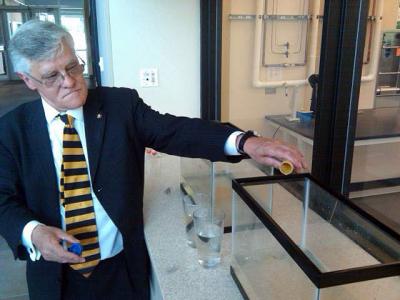Southern Miss Polymer Science Professors Create New Oil Dispersant
Thu, 04/21/2011 - 07:53am

The sight of pelicans and other native waterfowl coated in oil from last year's Deepwater Horizon explosion in the Gulf of Mexico sent University of Southern Mississippi polymer science professor Dr. Robert Lochhead straight to the laboratory.
After countless hours of testing and experimentation, Lochhead, along with polymer science colleagues Dr. Sarah Morgan and Dr. Daniel Savin, developed a dispersant that could make future oil spills a lot less catastrophic.
“When I saw all those birds covered in oil it was heartbreaking,” said Lochhead, chair of the Department of Polymers and High Performance Materials. “With my extensive background in surface materials, I just felt like there had to be something we could do to mitigate the effects of oil on the environment should a spill of that magnitude happen again.”
Lochhead and his colleagues headed to their Southern Miss lab where they came up with this newly-created dispersant. Different in so many ways from what is currently available, it became even more appealing by the fact that the ingredients are biodegradable. In fact, this new solution is also edible.
“That was one of our main objectives in this grant project – to create something that was bio-based, a naturally-sourced agent that would not be allowed to eventually deposit somewhere in the ecosystem,” said Morgan, associate professor in polymers and high performance materials and a co-investigator on the National Science Foundation (NSF) grant. “We're very excited about the potential that this new dispersant has shown in helping preserve the environment.”
As with all university-based research, one of the first orders of business is to obtain funding; which in this case came in the form of a $150,000 NSF rapid grant. The only catch is that this type of NSF grant includes a tighter time frame for productivity than others – just one year. Using a specially designed robot that allowed them to try thousands of compositions daily,Lochhead tested thousands of different combinations of materials before hitting the “Eureka” moment.
While not at liberty to reveal all of the new dispersant's ingredients, Lochhead did disclose that the primary agent is a common emulsifier.
“Soy lecithin, which is a byproduct of the soybean plant, is the main ingredient. It is also the primary emulsifier used in the chocolate products that we eat,” said Lochhead. “When mixed with oil, such as the type that spilled from the Gulf explosion, the dispersant will create emulsification that will cause the oil to literally fall off anything it touches.”
Lochhead points out that quick action is the key to effectively utilizing a product of this nature.
“Once the oil is spilled the idea would be to spray the affected area with the dispersant either from the air or boat before it can attach itself to plant life or waterfowl. If a bird swims through oil that has been sprayed with the dispersant, it will be able to fly away and shake the oil loose from its wings.”
Lochhead notes that a patent application for the dispersant is being filed. While awaiting approval, further testing will be done to develop a working prototype. That process could take up to a year or more. From that point significant environmental testing will be conducted by marine scientists and biologists before the product will be ready for mass production and distribution.
“Another important aspect of this discovery is that all of the ingredients are very common and easy to manufacture,” said Lochhead. “When a disaster such as the oil spill that occurred last year happens again, you will need millions of pounds of dispersant, not hundreds, as quickly as possible. And we'll be able to supply those needs with this dispersant.”
For more information about the Department of Polymers and High Performance Materials at Southern Miss call 601.266.4868 or visit http://www.usm.edu/polymer/